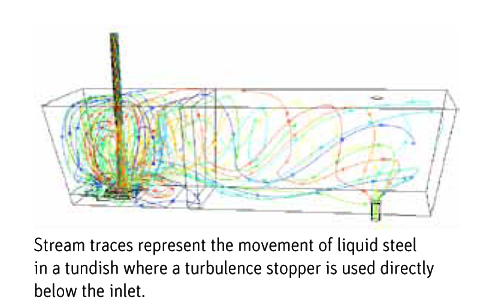Steel Authority of India Limited (SAIL) was looking for solutions to determine the best shape and use of flow control devices for a tundish, such as turbo-stoppers, in order to provide optimum flow characteristics that improve product quality. Finally they started using in ANSYS® Fluent®, a flow modeling simulation software from ANSYS, Inc.
Overview
During continuous casting of steel, the tundish is an important link between the ladle (a batch) and the continuous casting mold. The tundish acts as a reservoir and distributor of molten steel. When making quality steels, the tundish has the added responsibility of improving inclusion floatation and its separation. It also plays an important role in composition adjustment during casting of steel. The efficiency and optimization of these processes require close control of the molten steel flow behavior in the tundish. If the flow of metal in the tundish is not properly controlled, it may reduce the quality of steel produced.
Engineering Solution
- ANSYS Fluent software with the standard k-e turbulence model was used to model fluid flow in the tundish.
- Adaptive meshing based on velocity gradient was employed to generate a finer mesh in regions of high velocity gradient. A quarter of a million cells is needed to accurately capture the flow.
- The unsteady-state species transport model was used to generate the resident time distribution of the vessel.
- Inclusion floatation inside the tundish was analyzed using the discrete phase model (DPM). This helped to visualize the flow of these small inclusion particles and see whether they were trapped by the top surface layer.
Benefits
- The interactive user interface in ANSYS Fluent helped speed the analysis setup and subsequent post-processing.
- Adaptive meshing helped to refine the mesh where needed to keep the overall mesh count manageable.
- The accuracy of the simulation helped SAIL to understand precise variations in flow parameters including turbulent kinetic energy and turbulent energy dissipation. This led to meaningful insight in the process to make design improvements.
- Use of ANSYS Fluent reduces the cost of plant-scale experiments and testing.
Conclusion
By using the ANSYS® Fluent® SAID could speed up their analysis process and understand precise variations in flow parameters including turbulent kinetic energy and turbulent energy dissipation. “We rely on simulation software from ANSYS to improve flow in our tundishes to maintain our very high product quality standards,” says Rajeev Kumar Singh, Senior Manager, Process Simulation & Modeling Lab, RDCIS SAIL
Courtesy: ANSYS, Inc



